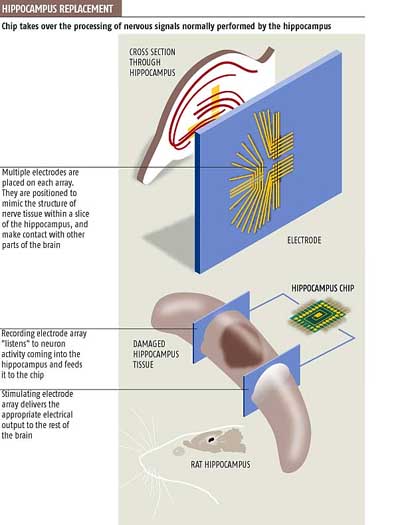World's first brain prosthesis revealed
The world's first brain prosthesis - an artificial hippocampus - is about to be tested in California. Unlike devices like cochlear implants, which merely stimulate brain activity, this silicon chip implant will perform the same processes as the damaged part of the brain it is replacing.Hippocampus replacement The prosthesis will first be tested on tissue from rats' brains, and then on live animals. If all goes well, it will then be tested as a way to help people who have suffered brain damage due to stroke, epilepsy or Alzheimer's disease.
Any device that mimics the brain clearly raises ethical issues. The brain not only affects memory, but your mood, awareness and consciousness - parts of your fundamental identity, says ethicist Joel Anderson at Washington University in St Louis, Missouri.
The researchers developing the brain prosthesis see it as a test case. "If you can't do it with the hippocampus you can't do it with anything," says team leader Theodore Berger of the University of Southern California in Los Angeles. The hippocampus is the most ordered and structured part of the brain, and one of the most studied. Importantly, it is also relatively easy to test its function.
The job of the hippocampus appears to be to "encode" experiences so they can be stored as long-term memories elsewhere in the brain. "If you lose your hippocampus you only lose the ability to store new memories," says Berger. That offers a relatively simple and safe way to test the device: if someone with the prosthesis regains the ability to store new memories, then it's safe to assume it works.
Model, build, interface
The inventors of the prosthesis had to overcome three major hurdles. They had to devise a mathematical model of how the hippocampus performs under all possible conditions, build that model into a silicon chip, and then interface the chip with the brain.No one understands how the hippocampus encodes information. So the team simply copied its behaviour. Slices of rat hippocampus were stimulated with electrical signals, millions of times over, until they could be sure which electrical input produces a corresponding output. Putting the information from various slices together gave the team a mathematical model of the entire hippocampus.
They then programmed the model onto a chip, which in a human patient would sit on the skull rather than inside the brain. It communicates with the brain through two arrays of electrodes, placed on either side of the damaged area. One records the electrical activity coming in from the rest of the brain, while the other sends appropriate electrical instructions back out to the brain.
The hippocampus can be thought of as a series of similar neural circuits that work in parallel, says Berger, so it should be possible to bypass the damaged region entirely (see graphic).
Memory tasks
Berger and his team have taken nearly 10 years to develop the chip. They are about to test it on slices of rat brain kept alive in cerebrospinal fluid, they will tell a neural engineering conference in Capri, Italy, next week."It's a very important step because it's the first time we have put all the pieces together," he says. The work was funded by the US National Science Foundation, Office of Naval Research and Defense Advanced Research Projects Agency.
If it works, the team will test the prosthesis in live rats within six months, and then in monkeys trained to carry out memory tasks. The researchers will stop part of the monkey's hippocampus working and bypass it with the chip. "The real proof will be if the animal's behaviour changes or is maintained," says Sam Deadwyler of Wake Forest University in Winston-Salem, North Carolina, who will conduct the animal trials.
The hippocampus has a similar structure in most mammals, says Deadwyler, so little will have to be changed to adapt the technology for people. But before human trials begin, the team will have to prove unequivocally that the prosthesis is safe.
Collateral damage
One drawback is that it will inevitably bypass some healthy brain tissue. But this should not affect the patient's memories, says Berger. "It would be no different from removing brain tumours," where there is always some collateral damage, says Bernard Williams, a philosopher at Britain's University of Oxford, who is an expert in personal identity.Anderson points out that it will take time for people to accept the technology. "Initially people thought heart transplants were an abomination because they assumed that having the heart you were born with was an important part of who you are."
While trials on monkeys will tell us a lot about the prosthesis's performance, there are some questions that will not be answered. For example, it is unclear whether we have any control over what we remember. If we do, would brain implants of the future force some people to remember things they would rather forget?
The ethical consequences of that would be serious. "Forgetting is the most beneficial process we possess," Williams says. It enables us to deal with painful situations without actually reliving them.
Another ethical conundrum concerns consent to being given the prosthesis, says Anderson. The people most in need of it will be those with a damaged hippocampus and a reduced ability to form new memories. "If someone can't form new memories, then to what extent can they give consent to have this implant?"
Duncan Graham-Rowe
Refs
and further readingHOME
SEARCH
Thought control?
Hypermotivation
'Brain pacemakers'
The Orgasm Command-Center
Computerising 'Sub-vocal' Speech
Electrodes in Brain to Switch Off Pain
The Transcranial Magnetic Stimulator
Out-of-Body Experiences and the Brain
Wireheads and Wireheading in Science Fiction
Persistent vegetative states and neurostimulation
Addicted brains; the chemistry of pain and pleasure
Pleasure Evoked by Electrical Stimulation of the Brain
dave@bltc.com

